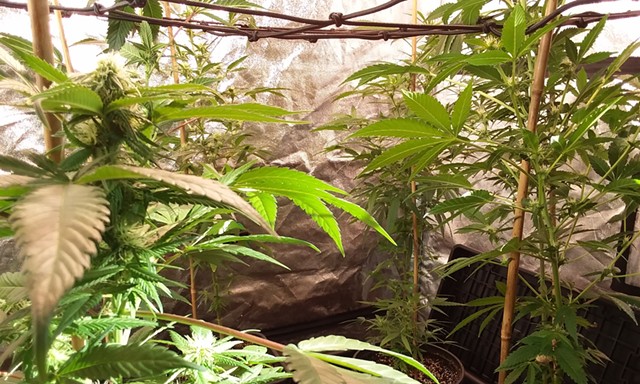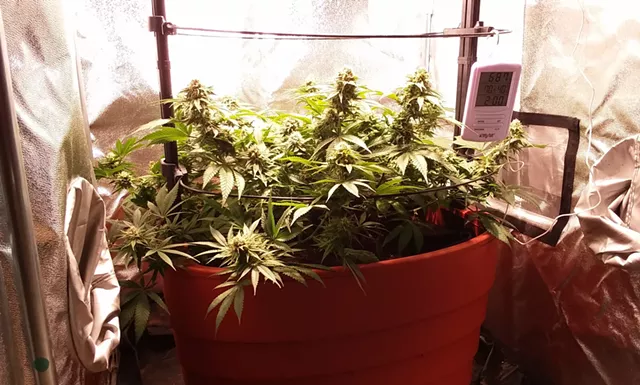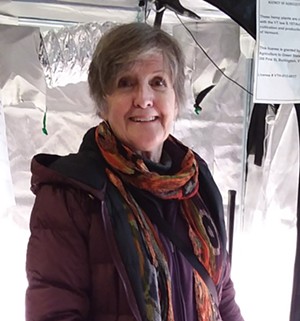Source: sevendaysvt.com

Hemp in a grow tent at Green State Gardener
In 25 years of growing organic veggies, I've never met a plant quite like cannabis. It responds to pruning the same way basil or broccoli does — by sending out multiple shoots that eventually flower. It thrives in nutrient-rich soil with the right amounts of light and water. And it's susceptible to the usual insects and diseases.
But terms like "mother plant," "screen of green," and "cloning" never quite enter the conversation when we're talking tomatoes and peppers.
Those cannabis terms rolled off Jahson Friedman's tongue on Saturday at Green State Gardener's "Free Cultivation Class: Vegging and Flowering" in Burlington. A GSG employee and registered medical cannabis cardholder, Jahson Friedman — who goes just by the name Jahson — is a consummate practitioner of the art and science of nurturing the flowering plant.
More than 35 men and women, from twenty-somethings to seventy-somethings, attended the class. It was the third in a four-class series GSG is offering this fall to the general public on growing cannabis, including best practices for germination, propagation and harvest as well as essential supplies and setups.
"Green State Gardener is part of the medical marijuana or hemp economy," said general manager Kelsy Raap as she welcomed the group. GSG is a Burlington-based company that provides indoor gardening supplies and information to the cannabis industry nationwide. The bulk of its sales are from special soil products and equipment for growing medical marijuana and high-cannabidiol hemp in the home, with a portion of sales attributed to cannabidiol, aka CBD, products.
The Saturday class would focus on high-CBD hemp plants grown indoors under the GSG hemp license, said 34-year-old Raap.
"We encourage everyone interested in growing cannabis to join Vermont's Hemp [Registration] Program," added Raap, emphasizing that the program not only allows the state to monitor and support the hemp industry but also can protect growers from misguided curiosity about their crops.
It has been legal to grow hemp in Vermont since 2013 and legal to grow medical marijuana since 2004. Both strains of cannabis can produce medical-grade CBD, but the latter is more heavily regulated. (For more on the legal status of cannabis in Vermont, see the Vermont Cannabis FAQ.)
Every home gardener knows that a few hundred things can go wrong with sensitive plants grown inside. Jahson, who's in his mid-40s, shared a mother lode of tips for yielding as many healthy flowers per plant as possible. The healthier the flower, the more pure, high-quality CBD can be extracted.
Jahson first described ideal soil conditions. He combines one part Vermont Compost's Fort Light blend — a light, living potting soil — with one part Coast of Maine's Stonington Blend Grower's Mix — a heavy, rich soil. Adding some bat guano and a few other nutrients creates what he considers the best medium for growing cannabis.
"If the soil is nutrient-rich, there's no need for fertilizers," said Jahson, an avid proponent of organic methods. He warned against fertilizer not only because it can adversely affect the final product's taste, but also because it encourages tall plants. The state requires that medical marijuana be grown in a "single, secure indoor facility," and most home growers can't accommodate tall plants. But Jahson also believes shorter, fuller plants offer superior flowers.
Ideal soil pH for cannabis is 6.3-6.5, and ideal water pH is 5.8-6.8, he said. Like any veggie seedling, cannabis does best when repotted a few times as it matures, and, like some other plants, it performs best when pot-bound.
Jahson uses a few organic sprays weekly to discourage insects such as aphids and spider mites and monitors air temperature and humidity carefully to avoid mildews and other diseases. When cannabis is in its vegetative or nonflowering state, the ideal air temperature is 70-80 degrees, and ideal humidity is 50-65 percent. When the plant is flowering, the temperature should be near 80, and humidity reduced to 40 percent. (Oh, my. Dear cannabis is rather high maintenance.)
Although cannabis will grow under florescent lights, Jahson recommended ceramic metal halides, which aren't cheap but provide optimal conditions. The plant shifts into its flowering phase because of a change in the amount of daily light. Eighteen hours of light keeps it in a nonflowering state; decreasing that amount to 12 induces flowering.
But beware of that light switch! If you accidentally turn on the light at the wrong time, cannabis plants are severely thrown off, may produce a reduced yield and can develop, well, health issues. (A tomato plant would never freak out like that.)
Cannabis creates clusters of flowers and buds called "colas" at the very top of the plant and at sites on the lower branches. Before the buds are harvested, growers must flush cannabis soil with gallons of water to get rid of salts and minerals that could affect CBD purity and taste. (Jeeze, talk about sensitive.)
But before growers even think about shifting that timer dial, precise pruning is required to fill the "screen" — the topmost area of the plant where flowering occurs. Jahson described three pruning methods: "screen of green" aka SCROG, topping, and FIM, which requires the most precision and care and stands for "Fuck, I missed!" Assuming you don't miss, each method encourages the plant to grow wide rather than tall and to produce 30-40 flowers.
There are many strains of cannabis that produce CBD of varying qualities and potency. Jahson recommends that each grower have a "mother plant" — a favorite from which to take cuttings for propagating or "cloning" new plants. While cannabis can be grown from seed, once growers find a great strain, they tend to stick with it through cloning.
Throughout the class, Jahson drew direct comparisons between the way growers manage cannabis plants and the potency and purity of the resulting CBD. "If you treat them with love and take care of them," he said, "they'll do the same for you when you ingest them as medicine." He was emphatic that people using CBD medically learn everything they can about how and where it was produced. "Anything that goes into the plant goes into your body," he added.
After an hour and a half of discussion, during which Jahson answered numerous questions from novice and experienced growers, the group followed him into GSG's showroom to view growing kits designed for home use.
A number of people asked that I not take their photos, so I shot some great shoes instead. One attendee was happy to have her picture taken — Charlene Young of Jericho. She's been taking CBD for about six months to ease symptoms from primary progressive multiple sclerosis.
"I've gone off two pharma meds, which is terrific," said Young. "Within a week, I felt relief from spasticity in my left leg and foot and could sleep much better." She's a CBD convert and knows many other people with multiple sclerosis who've benefited from taking the product.
As I walked out into the November sunshine, I thought, Well, basil and tomatoes may not have the same palliative or curative power as cannabis, but at least they're wholesome and delicious — and a heck of a lot easier to grow.




No comments:
Post a Comment